When an engine with an integral radiator is installed in an engine compartment the fundamental principal is to remove hot air from the compartment and, using minimal circulation, draw in air that has the same temperature as the ambient air outside the compartment. The illustration shows the most suitable engine location in relation to the structure's walls. The objective is to draw in cool air at the lowest possible point and expel it through the radiator and out of the structure. It is unsuitable to locate the engine so that the radiator is next to the opening in the wall. This would cause hot air to circulate back to the cooling fan through the gap between the radiator and the wall when the engine is running.
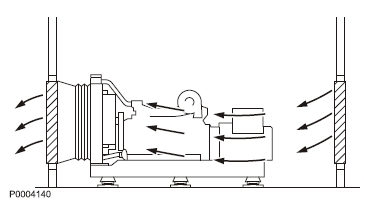
This results in inefficient cooling and may cause overheating problems. The discharge opening in the wall must have a free flow aperture that is approximately 25 % greater than the radiator frontal area, and have the same rectangular shape. A sheet metal or plastic duct must be installed in the aperture frame with a flexible connection to the radiator duct flange. The flexible part is especially important when the engine is mounted on a floating concrete block or vibration-dampening mounts. The inlet opening must also have a free flow aperture that is at least 25 % greater than the radiator frontal area. When the inlet and outlet openings are designed, attention must be paid to the fact that the cooling fan has a maximum limit for external resistance, namely “inlet to fan plus outlet from radiator”. This limit must not be exceeded, otherwise cooling air flow will be reduced. Inlet and outlet openings are normally equipped with
mesh, grilles, noise dampening panels or inner and outer ducts. Regardless of what is installed, it will involve airflow resistance, and it may be necessary to enlarge the aperture further. The large volume of air moved by the cooling fan usually provides sufficient engine compartment ventilation. As shown in the illustration, cold inlet air is drawn over the generator (which takes its cooling air from this flow), over the engine intake filter and engine. The cooling fan then expels air through the radiator and out of the structure. No airflow obstacles are allowed directly in front of the radiator outlet and the deflectors etc. If high engine compartment temperatures are unavoidable, the inlet air temperature to the engine air filter must be checked so that it does not become too high.
The temperature of the engine inlet air must be as low as possible; read more about this under de-rating in the Sales Support Tool, Partner Network. If inlet air temperature constantly exceeds the maximum limit, engine power will be reduced according to the data specified for the engine concerned. The illustration shows the air inlet location high up on the wall. This is acceptable if the air is led to the rear part of the generator.
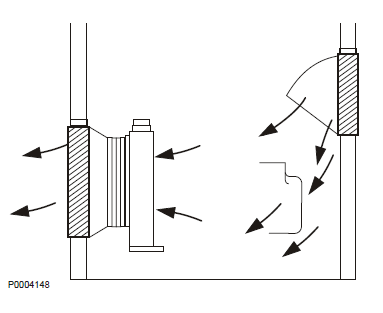
Inlet air from outside of the engine compartment The air intake must be located so that inlet air is as clean as possible and so that neither exhaust gasses from the engine nor hot air from the radiators mixes with inlet air. The air inlet must be protected so that water, snow or other contaminants are prevented from entering (being drawn in) during operations. Refer to the instructions regarding maximum permissible pressure drops in the Sales Support Tool, Partner Network for each engine type. The value includes the pressure drop with a new, clean air filter and a coarse filter connected in the fresh air duct.
• Air ducting may not have tight bends.
• Air ducting must have smooth inner surfaces.
• The hose used must be reinforced to prevent collapse due to suction.
Pressure drop measurement is usually carried out at the pressure drop indicator. The total pressure drop in an inlet system with a blocked filter may not exceed the value stated in the technical data for the engine concerned. If the pressure drop (low pressure) is too great, there is also a risk that the engine will not receive sufficient air, which may lead to engine problems.
When inlet air is taken from outside the engine compartment, it is important to check that the temperature in the engine compartment does not exceed 60 °C (140 °F). If the temperature exceeds this value, there is a risk of functional problems in the engine electrical components (alternator, charge regulator, stop solenoid). It may therefore be necessary to equip the engine compartment with a ventilation fan if there is a risk of the temperature exceeding 60 °C (140 °F). Refer to the “Forced ventilation” chapter. When engine compartment ventilation is dimensioned, consideration must be given to other devices that consume air in the compartment.
Example:
For a radiator frontal area of 1.25 m2, the outlet and inlet wall openings must have an area of 1.56 m2. If a mesh is to be installed, the opening must be increased to 1.95 m2. Refer to the illustrations.
A Radiator frontal area
B Air inlet or outlet
C Mesh 80 % free aperture
D Size of air inlet / outlet to fit mesh
E Effective height
F Size of air inlet / outlet to fit grille
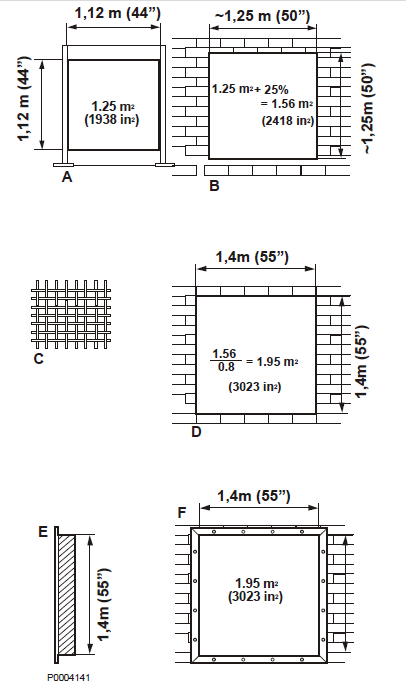
Objects in airflow
The space available for the engine is usually very limited in many applications. For example, a fork lift counter balance weight or a supporting wall outside a generator set compartment may restrict the available space. Such objects constitute a hinder to cooling airflow to or from the radiator assembly.
The illustrations provide an overview of installation layout.
One-sided air inlet our outlet (hood)
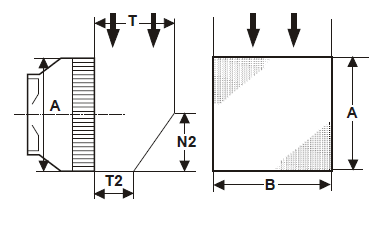
T ≥ A Extraction cooling and overpressure cooling
B ≥ A Extraction cooling and overpressure cooling
Air inlet or outlet from all sides
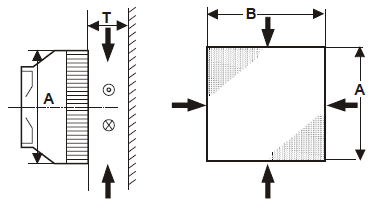
T ≥ 0.2 x A Extraction cooling
T ≥ 0.4 x A
B ≥ A
Overpressure cooling
Overpressure cooling
Double-sided air inlet or outlet
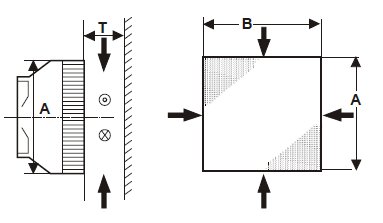
T ≥ 0.4 x A Extraction cooling
T ≥ 0.6 x A
B ≥ A
Overpressure cooling
Overpressure cooling
For More Volvo Engine workshop information, please visit
Volvo Engine Characteristics and Engine Performance
General Information of Volvo Industrial Engines
Copyright © Guangxi Dingbo Power Equipment Manufacturing Co., Ltd. All Rights Reserved | Sitemap
Update cookies preferencesseokeywords:
test2